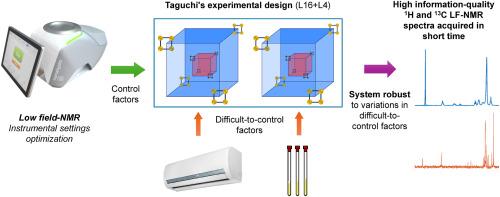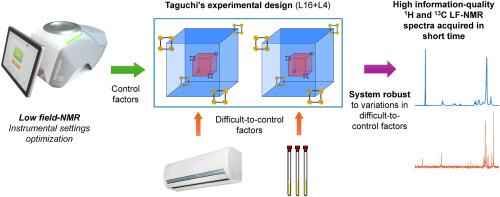Optimising the acquisition conditions of high information quality low-field NMR signals based on a cutting-edge approach applying information theory and Taguchi's experimental designs – Virgin olive oil as an application example
IF 5.7
2区 化学
Q1 CHEMISTRY, ANALYTICAL
引用次数: 0
Abstract
Background
Developing a new spectrometric analytical method based on a fingerprinting approach requires optimisation of the experimental stage, particularly with novel instruments like benchtop low-field NMR spectrometers. To ensure high-quality LF-NMR spectra before developing the multivariate model, an experimental design to optimise instrument conditions is essential. However, difficult-to-control factors may be critical for optimisation. Taguchi methodology addresses these factors to obtain a system robust to variation. This study uses the Taguchi methodology to optimise instrument settings for acquiring high-quality 1H and 13C LF-NMR signals in a short time from virgin olive oil (VOO).
Results
Two experimental trials (for 1H and 13C signals, respectively) were carried out and analysed to find an optimal and robust combination of instrument settings against changes in two difficult-to-control factors: ambient temperature and small deviations of the NMR tube volume (700 ± 50 μL). The responses to be optimised, run time and spectral information quality, were analysed separately and jointly, as some factors showed opposite behaviour in the effect on the responses. Multiple response analysis based on suitable desirability functions yielded a combination of factors resulting in desirability values above 0.8 for 1H LF-NMR signals and almost 1.0 for 13C LF-NMR signals.
In addition, a novel approach to assess the information quality of an analytical signal was proposed, addressing a major challenge in analytical chemistry. By applying information theory and calculating information entropy, this approach demonstrated its potential for selecting the highest quality (i.e. most informative) analytical signals.
Significance
The acquisition instrument conditions of LF-NMR were successfully optimised using Taguchi methodology to acquire highly informative 1H and 13C spectra in a minimum run time. The importance lies in the future development of non-targeted analytical applications for VOO quality control. In addition, the innovative use of information entropy to a priori assess the signal quality represents a significant advance and proposes a solution to a long-standing challenge in analytical chemistry.


基于应用信息论和田口试验设计的前沿方法优化高信息质量低场核磁共振信号的采集条件--以初榨橄榄油为例
背景开发基于指纹识别方法的新光谱分析方法需要优化实验阶段,尤其是台式低场 NMR 光谱仪等新型仪器。为了在建立多元模型之前确保高质量的低场 NMR 图谱,优化仪器条件的实验设计至关重要。然而,难以控制的因素可能是优化的关键。田口方法可解决这些因素,从而获得一个对变化具有鲁棒性的系统。本研究使用田口方法优化仪器设置,以便在短时间内从初榨橄榄油 (VOO) 中获取高质量的 1H 和 13C LF-NMR 信号。结果进行了两次实验(分别针对 1H 和 13C 信号),并对实验结果进行了分析,以找到针对两个难以控制的因素(环境温度和 NMR 管容积的微小偏差(700 ± 50 μL))变化的仪器设置的最佳稳健组合。需要优化的响应、运行时间和光谱信息质量分别和联合进行了分析,因为某些因素对响应的影响表现出相反的行为。根据适当的可取性函数进行多重响应分析,得出了各种因素的组合,结果是 1H LF-NMR 信号的可取值高于 0.8,13C LF-NMR 信号的可取值接近 1.0。通过应用信息论和计算信息熵,该方法证明了其在选择最高质量(即信息量最大)分析信号方面的潜力。这对未来开发用于 VOO 质量控制的非目标分析应用具有重要意义。此外,创新性地使用信息熵来先验评估信号质量是一项重大进步,并为分析化学中的一个长期挑战提出了解决方案。
本文章由计算机程序翻译,如有差异,请以英文原文为准。
求助全文
约1分钟内获得全文
求助全文
来源期刊

Analytica Chimica Acta
化学-分析化学
CiteScore
10.40
自引率
6.50%
发文量
1081
审稿时长
38 days
期刊介绍:
Analytica Chimica Acta has an open access mirror journal Analytica Chimica Acta: X, sharing the same aims and scope, editorial team, submission system and rigorous peer review.
Analytica Chimica Acta provides a forum for the rapid publication of original research, and critical, comprehensive reviews dealing with all aspects of fundamental and applied modern analytical chemistry. The journal welcomes the submission of research papers which report studies concerning the development of new and significant analytical methodologies. In determining the suitability of submitted articles for publication, particular scrutiny will be placed on the degree of novelty and impact of the research and the extent to which it adds to the existing body of knowledge in analytical chemistry.
 求助内容:
求助内容: 应助结果提醒方式:
应助结果提醒方式:


